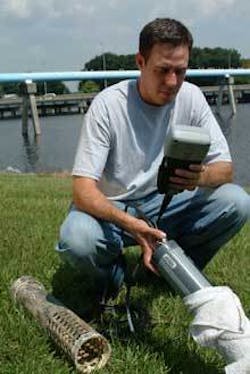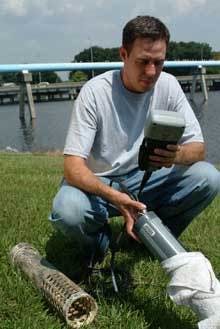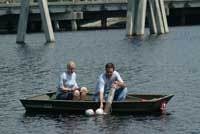Building a Baseline Florida Embarks on Water Quality Study
The Florida Department of Environmental Protection (DEP) knows that establishing dissolved oxygen (DO) and nutrient criteria for the state’s water bodies is a challenge - both scientifically and politically. To strengthen the scientific basis of its upcoming discussion of nutrient and DO levels statewide, DEP has embarked on a comprehensive, year-long study of those parameters in hundreds of Florida’s diverse waterways, which range from natural to manmade water bodies and from crystal clear to tea-colored water systems.
The study draws upon state-of-the-art sampling equipment and analytical tools, highly trained analysts, and meticulous protocols. Grab-sample data will be augmented by continuous monitoring data, providing an unprecedented level of detail on the state’s water quality.
By the end of the study, the project’s 342 sampling sites will have yielded more than a half-million data points and, officials hope, perspective on nutrients and DO concentrations in the state’s waterways. That perspective will be invaluable in establishing science-based criteria for acceptable levels of DO and nutrients in the state’s diverse water bodies.
“The purpose of this project is to help the State of Florida revise its standards for dissolved oxygen and establish quantitative nutrient criteria,” said Eric Livingston, chief of the DEP’s Bureau of Watershed Management in Tallahassee. “To do that you need data - lots of data.”
An abundance of data translates into flexibility in setting the new criteria.
“We really are going into this without any preconceived notions of what the standards will look like,” said Garry Payne, environmental manager at the DEP’s office in Tallahassee. “We’re leaving the doors open to look at site-specific alternative criteria like we have in the Everglades for DO, which depend on diurnal monitoring. We’ll have the data we need - and we don’t want to have to do it again. We wanted to be able to do it all in one shot.”
The need for science over politics wasn’t lost on state lawmakers.
“The Legislature recognized the importance of good data and allocated the funds to undertake this study,” Livingston said.
The state hopes to see a good economic return in the form of cost savings for businesses and residents of watersheds where Total Maximum Daily Loads (TMDLs) will require Best Management Practices and environmental safeguards that will hinge, in part, on the results of the DEP research.
Study Design
The first challenge was defining the kinds of water bodies that would be studied and selecting enough sites to generate statistically significant results. Working with Biological Research Associates (BRA) and its team of sub-consultants to fine-tune the sampling site list, DEP developed a list of water body types and targeted the number of sites to be sampled in each:
- Large river (30 sites)
- General stream (45)
- Low-velocity stream (30)
- Urban stream (60)
- Natural lake (90)
- Urban lake (60)
- Canal (30)
Each of the sites is undergoing an intensive monitoring regimen, said Doug Durbin, BRA vice president who heads the study team. Teams collect grab samples at each site for total Kjeldahl nitrogen (TKN), ammonia, nitrate + nitrite, total phosphorous, total organic carbon, chlorophyll a, and color. Turbidity is measured in the field, and biological and sediment samples are also collected for analysis during selected sampling trips.
“This is one of the biggest statewide efforts of this type I’ve ever been involved in,” said Payne, who also worked on the high-profile effort to set nutrient criteria for the Everglades. “The Everglades is probably one of the most environmentally studied pieces of earth in the world. We had probably 10 years’ or more of data for the Everglades to set the standards down there. We just don’t have that kind of data for the water bodies across the state. Our previous statewide ambient monitoring data covered a lot fewer sites, one season out of the year, a lot less intensively. To set the standards for the state, we knew we needed a lot more data.”
In the new effort, continuous monitoring data - shedding light on diurnal cycles and reactions to different weather events - is a critical part of the study. Every three months, analysts deploy YSI 6600EDS sondes at each site at a half-meter depth. Each sonde measures water temperature, conductivity, pH, DO and depth every 15 minutes for four days. When the sondes are deployed, another YSI 6600EDS - configured for water column sampling - is used to grab a snapshot of the same data at half-meter increments throughout the water column.
The sondes’ data is downloaded into YSI 650 dataloggers. Additional data on the sampling site - including air and water temperature, velocity, biological information, and who is present at the time - are recorded in Symbol personal data assistants (PDAs), and all equipment and personnel identification codes are logged in with individual barcodes to aid in QA/QC efforts.
Fortunately, data quality has been excellent. Even in challenging extended deployment situations, the long-term unattended monitoring equipment has performed reliably. In Florida, “challenging” deployments range from hurricane surges to extensive fouling to alligator attacks. (In fact, the BRA team has learned to wrap its buoys in heavy wire mesh to discourage territorial ’gators from chewing up the floats and dislodging the sondes.)
Every analyst has a favorite survival story about the sondes that illustrates their durability.
“One sonde fell to the bottom in 20 feet of water,” said BRA senior water resource analyst Kym Rouse Campbell. “It spent six days on the bottom in the muck and collected data the whole time - and verified.”
In fact, she said, she has seen very few sondes come back from deployment and fail to verify.
After Hurricane Katrina blew through South Florida in August, sonde pickups were delayed for days beyond their scheduled four-day deployments. The BRA team reports that after a full week in the field, including the storm, the entire group of sondes picked up after the hurricane stayed within DEP’s ± 0.3 mg/L tolerance standard for DO.
Diligent maintenance protocols - along with the training and follow-up tech support provided by YSI - help keep the equipment in top shape and keep the complicated project moving ahead, Durbin said.
“The tech support from YSI turned out to be an incredible money-saving factor,” he said.
Data Analysis
The data collection effort is providing a comprehensive look at each sampling site that takes into account the entire water column, an array of water quality parameters, and how DO changes over time. Put them together and water resource scientists should be able to understand how the water bodies function, and how different systems compare and contrast.
“The state is well aware of the importance of considering the differences among water bodies,” Durbin said. “The thing this study is trying to do is quantify the degree and variability of those differences.”
Understanding the relationships among water bodies is no small challenge, Durbin noted. As part of a QA/QC review for the project, Durbin churned thousands of data points through YSI’s EcoWatch® for Windows® to chart the monitored parameters over four-day study periods at each study site.
The resulting charts hint at the challenges that face regulators and stakeholders as they seek acceptable limits for DO and nutrients.
“It’s pretty astounding how much variability there can be,” Durbin said.
Some water bodies revealed strong diurnal cycles, with DO rising and falling dramatically; others were remarkably stable. Among the sites with significant peaks and valleys, some showed strong positive correlations with temperature (and, consequently, daytime vs. nighttime) while others displayed strong negative correlations. The bottom line, said Durbin, is that DO patterns will need to be referenced against other water quality parameters and physical factors to generate a more complete understanding of the water body.
For more information about YSI’s extended deployment data collection instruments, visit the company’s website at www.ysi.com/environmental.
About the Author:
Steve Werblow, based in Ashland, OR, covers environmental and agricultural topics. A 1988 graduate of Cornell University’s College of Agriculture & Life Sciences, he has been a freelance writer since 1995.


